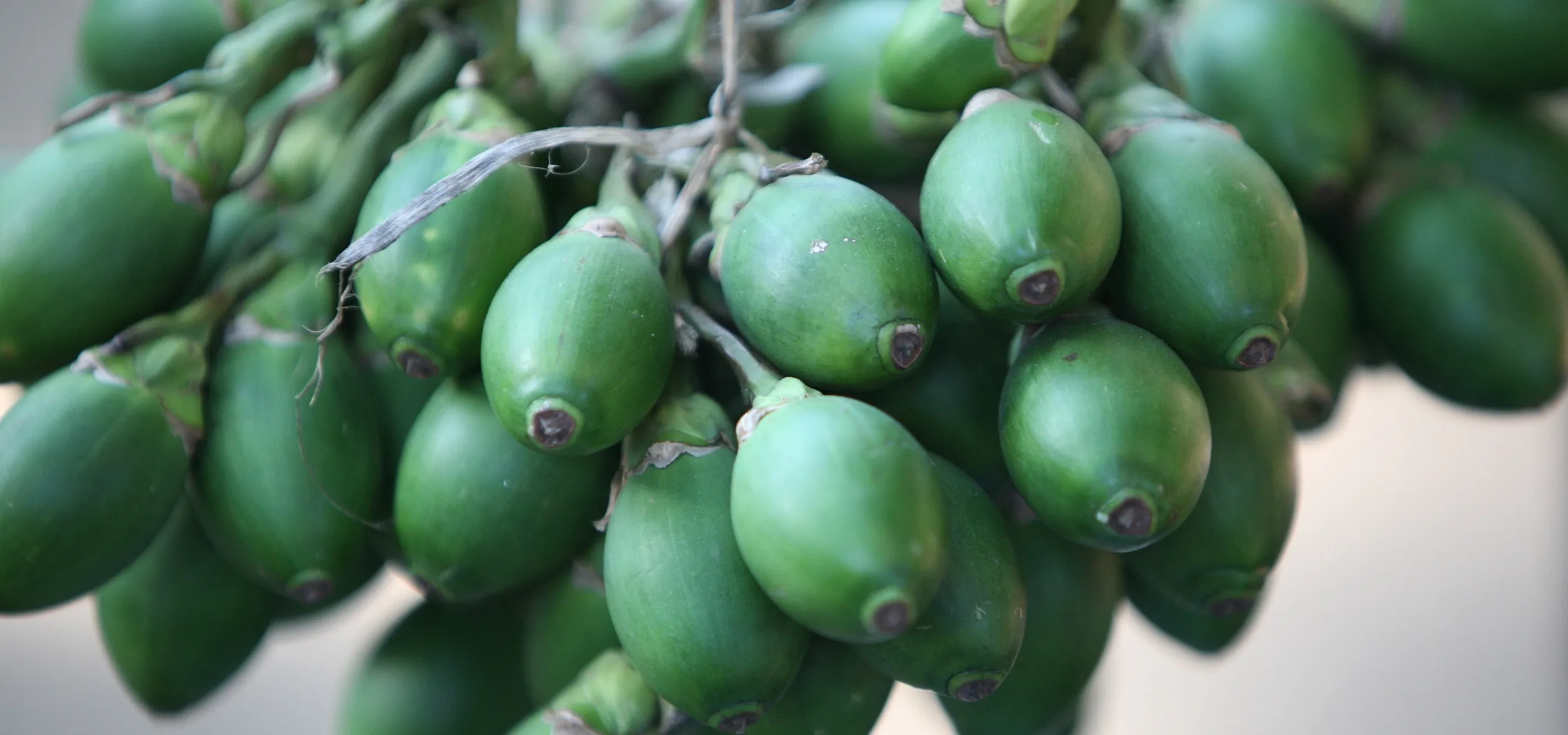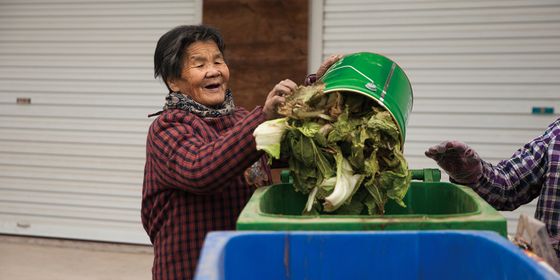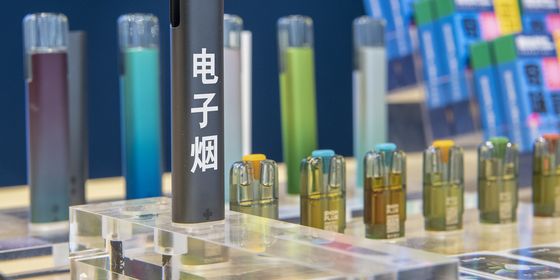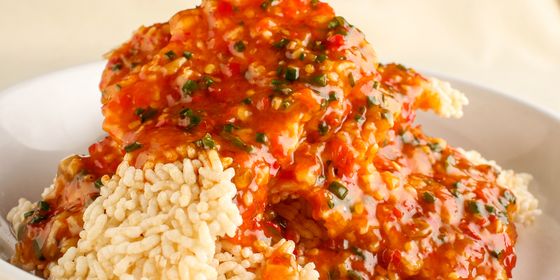China’s addictive snack, binglang, is part carcinogen, part cultural heritage
There is a muscle, three centimeters wide, that protrudes from Mr. Gu’s left jaw as he speaks. When he swallows or pauses to think, it retreats into the side of his cheek, but returns almost immediately as he picks up his tale.
The bulge is just the right size to hold a half-slice of binglang, the psychoactive nut that the 60-year-old motor-cab driver almost never stops crunching during the day, just as he never stops praising its health benefits. “I’ve been chewing since I was 8 or 9 years old…and my blood circulation is excellent. There’s never been anything wrong with my health in my life,” Gu brags with a red-stained smile, “except that most of my teeth have been worn down.”
Binglang, which grows from the areca palm, is a fruit of contradictions. Though often called “betel nut” in English, it’s technically a berry rather than a nut, and unrelated to the betel vine—that’s the plant whose leaf produces the red saliva when eaten along with the fresh green nut (along with a generous slathering of slaked lime, tobacco, and other flavorings) as a snack known as “betel quid” throughout South and Southeast Asia. In Hainan, China’s southernmost province, locals like Gu swear by binglang’s alleged medicinal properties, which include everything from stimulant to aphrodisiac to digestive aid, yet a 2017 research paper by the US National Cancer Institute declared it a “neglected global public health emergency.”
The effect of biting into binglang has been compared by fans to drinking six cups of coffee, giving the eater an initial dizzying rush of euphoria, followed by a feeling of warmth and a heightened level of alertness. Critics, though, say it’s more like smoking three cigarettes, or chewing tobacco. The World Health Organization classifies the areca nut as the fourth-most addictive substance in the world, after caffeine, alcohol, and tobacco, and both the nut and betel quid as carcinogens linked with higher rates of oral, stomach, and liver cancer. In Hunan, the PRC’s other major binglang-chewing province, oral cancer rates are “significantly higher than the national average” according to a 2018 statement by the provincial Office of Cancer Research and Prevention.
Lime is spread on the betel leaf to improve the taste (Hatty Liu)
Domestic exposés are accordingly on the rise, most notoriously Shenzhen TV’s Men with Cut Faces in the Binglang Kingdom, a 2013 documentary that featured graphic images of lifelong areca-eaters in Hunan with parts of their cheek or tongue removed and reconstructed due to cancer, as well as consumers with flesh-eating tumors, stained and cracked teeth, abrasions inside their mouth, and holes in their cheek. The same year, CCTV’s News 30 program explored the nut’s cancer risks, and in 2017, the China Food and Drug Administration translated and republished the WHO’s list of cancer-inducing substances on its website, areca among them.
These criticisms are proving tough to swallow for the communities already deeply dependent on binglang—both as a business and culture. “Every three to five years, there’s a controversy, an attempt to smear binglang,” declares Peng Shangwen, general manager of Hainan’s Yali Agricultural Development Company, a dried-binglang manufacturer which hosts the recently opened Wanning Municipal Areca Museum on its campus.
The museum is “a joint project by our company, the Wanning Binglang Bureau, and the city government, that uses artifacts associated with binglang to showcase Hainan’s agricultural heritage, culinary heritage, folk heritage, literary significance, and inheritance from its ancestors,” Peng explains to TWOC.
Similarly, last year, the Hunan Binglang Industry Association applied for “intangible cultural heritage” status for its provincial “binglang culture,” already a municipal heritage item in the city of Xiangtan since 2007. In March, the same association banned local binglang enterprises from advertising their products nationwide, raising the hopes of some anti-binglang activists, until president Yang Xun clarified to Xinhua News Agency that they simply wanted to “standardize” competition: “It’s not because binglang causes cancer like everyone thinks.”
“Binglang cultivation goes back thousands of years, and it’s only in the last 20 years that people have been saying [critical] things,” Peng says. “I’m not going to comment on those, only that, with 2 million people involved in binglang cultivation in Hainan, any attempt to say it’s cancerous is going to be taken as a criticism of the locals themselves.”
***
Out on the streets of Changfeng, the town outside Wanning where Yali is headquartered, Ms. Fu, the owner of a dry-goods store near where Gu parks his motorbike, is venting against what she perceives as media busybodies bent on destroying local industry.
The areca nut is eaten raw in Hainan and Taiwan (Hatty Liu)
“Look at all these people around you, who’ve eaten binglang all their lives. Does anyone have cancer? Is anyone dead?” Fu rails. “It’s all lies! They keep coming around to say binglang is bad for you, so who will buy from our farmers anymore? It will be a disaster!”
“We have nothing else of value here,” Fu insists to TWOC. “If you take away binglang, then Hainan wouldn’t have any special characteristics left.”
Binglang has been associated with Hainan since the 12th century, though it has been consumed locally for much longer. The areca palm has been cultivated across Southeast Asia and the Pacific for several millennia, and the method of eating the nut with the betel leaf may have emerged in the Philippines 4,000 years ago. By the Northern and Southern Dynasties period, it had already appeared on the Chinese mainland as a tribute item for the emperor, but was not yet widely consumed.
In 1097, back when Hainan was a holding pen for disgraced officials from the central empire, its most famous exile, the poet Su Shi, arrived on the island. Apparently, indigenous families of the Li ethnicity warmly welcomed the fallen litterateur into their homes with glossy areca, a custom he immortalized in several well-known poems: “The wary northern guest was persuaded with difficulty to eat…The surface is hard but the taste is charming,” goes the aptly titled “Eating Binglang.”
By Su’s time, binglang was also being traded in China’s southeastern coastal regions to help with odor removal, insect control, and indigestion—essential to northern settlers trying to acclimate to the humid south. Chinese medicine also attributed panacea-like qualities to the fruit: Tomes such as the Famous Doctor’s Records (220 – 450), Tang Materia Medica (659), Ri Huazi Materia Medica (c.10th century), and Compendium of Materia Medica (1552) cited its effectiveness for killing stomach parasites and treating boils and sores, athlete’s foot, muscle pain, joint discomfort, and malaria, among dozens of other uses.
It was also as medicine that binglang came to Hunan in either 1647 or 1649, when the inhabitants of Xiangtan were massacred by the conquering Manchu army for resisting their rule. This resulted in a plague epidemic, and legend says that Buddhist monks began chewing binglang in order not to succumb while cleaning up the bodies. A less dramatic explanation states that Xiangtan was an important hub in the Chinese medicinal herb trade in the late Ming and early Qing dynasties, and the habit started with curious local merchants who began sampling the nut that they sold.
Dried binglang may have added ingredients like goji berries and coffee beans (photo courtesy of Yali Binglang)
In Hunan, the areca nut evolved into its dried form as locals removed the seed and preserved the husk with spices, producing a taste that’s supposedly reminiscent of the peppery local cuisine, and equally bracing during the wet and chilly winter. Chewing and gifting the dried brown snack has become a cornerstone of Xiangtan social life, on par with cigarettes and alcohol elsewhere (at many gatherings, all three are consumed together). “It’s like eating watermelon seeds or peanut candy during Chinese New Year. It’s practically a necessity when locals hold weddings or funerals, entertain guests, or go out to do business,” says Zeng Yabin, a 26-year-old Hunan native who works in a binglang delivery business in Guangdong province.
Down in Hainan, a local saying insists that “there’s no etiquette without binglang,” and folk songs record the nut’s history as a betrothal gift and wedding snack among the Li and Miao minorities: “Chewing binglang and singing a song, I go with red lips to meet my love,” goes one tune, while another states, “A man gifts binglang and a woman gifts ash (lime), no matchmaker needed to be lovers or friends.”
These quaint ditties had a modern counterpart in increasingly sophisticated TV binglang ads, which resembled cigarette ads of the last century, at least until Hunan’s recent ban. Commercials featuring beautiful women and young men with flashy cars, sharing binglang inside pulsating nightclubs, project a youthful and upscale image on the traditional chew.
Like many in the industry, Zeng disputes claims that the nut is harmful: “We’ve had a 400-year history of eating binglang [in Hunan]; people wouldn’t eat it like candy if it was cancerous.” Hunan’s industry association has suggested that only the raw areca is dangerous, whereas dried binglang has had any potentially cancer-causing impurities sifted out (while fans of the raw betel quid more common in Hainan argue just the opposite).
Yali manager Peng, who has chewed for 16 years, and developed the well-known muscular “square jaw” that marks the binglang eaters, insists any health risks can be managed with better self-control. “If you drink too much it’s bad for your liver, if you smoke too much it’s bad for your lungs; everything needs to be taken in moderation,” he retorts, recommending two of his company’s 25-gram binglang packs as the daily maximum.
However, “I myself eat three of those packs a day,” he adds, ripping open a bag of Yali’s coffee-flavored binglang, and popping a slice in his mouth.
***
Not all locals are binglang enthusiasts—some are active critics. “Actually, you can get addicted,” says Mr. Wu, an employee of a tobacconist which sells the raw nut, explaining his aversion. “It’s too strong, like alcohol, and once you start, you can’t stop.”
Compared with decades of research on tobacco, there are fewer studies into binglang’s risks. It can also take up to 20 years for cancer symptoms to manifest, making it difficult to communicate the risks to those who may not experience any ill effects for years to come.
Many factories steam the raw nut to make dried binglang (photo courtesy of Yali Binglang)
Moreover, the regulatory inertia and appeals to culture are entwined with the economic importance of the industry, which had been declining in Xiangtan until the 1980s, when authorities began subsidizing dried binglang processing factories as a local “characteristic” industry to compete in the new market economy.
Today, Xiangtan’s binglang industry employs 300,000 people, and generated 20 billion RMB in revenue in 2017, a number that local authorities wish to increase to 50 billion by 2022. In Hainan, where most of China’s raw nuts are grown, binglang cultivation is part of a provincial effort to develop “characteristic tropical agriculture,” a slogan proposed by President Xi Jinping in 2018.
“It’s not possible at the current time for the state to make any law or regulation against binglang, because they would have to start by shutting down the enterprises,” says Yuan Hui, a Xiangtan native who dislikes the habit. “All that the government can do is to promote the message that it’s bad for you, and let people make their own decisions.”
The mainland, however, is even lagging in this respect. By contrast, in Taiwan, the government provides free cancer screenings and programs to help quit binglang, produces public service ads featuring images of addicts with mouth tumors, and has hosted an annual “Abstain from Binglang Day” since 1997.
In India, several states have tried to ban the sale of the nut, and clear images and warnings of its cancer risks are printed on the packaging. Chinese enterprises like Kouweiwang and Yali, though, only print that “Excessive binglang consumption may be harmful to the health,” while other brands even promote their product with slogans like “Delicious without harming the mouth” and “Nationally certified safe food.”
Yuan believes denial, rather than ignorance, is what fuels her area’s binglang habit. “In truth everyone knows the harm of binglang, like everyone knows the harm of smoking, but they’re just addicted,” she claims, having given up convincing family members to quit. “They’re adults…unless they’re willing to give it up, nothing anyone says will make any difference.”
“I don’t find it a culture particularly worth preserving, but I’ve decided to just let it be,” she says.
Down in Yali’s factory, Peng alleges that the WHO reports don’t apply to Hainan because they’re based on “Indian and Malaysian areca,” which are supposedly harmful because they are more fibrous and preserved by smoking—a technique once common in China that has been replaced by steaming, he emphasizes.
The locals, too, are struggling to reconcile increasing international scrutiny with the ingrained habit of generations. “How do you know those people with cancer got it from binglang?” Ms. Fu demands. “A lot of them smoke too. Or maybe it’s those spices, that mint they put in when they make dried binglang, that causes cancer.”
“I wouldn’t say I’m addicted,” Mr. Gu offers. “Only, if I don’t have it in my mouth, I think something is missing.”
A seller in nearby Xinglong town, also surnamed Wu, agrees. “If you tell me it develops cancerous properties in the process of being dried and preserved, that’s reasonable,” he says, spitting a mass of fibrous binglang detritus into a reddened napkin, and reaching for a new raw nut. “But this…it comes from a tree. How can it be dangerous?”
Tough Nut to Crack is a story from our issue, “Funny Business.” To read the entire issue, become a subscriber and receive the full magazine.












